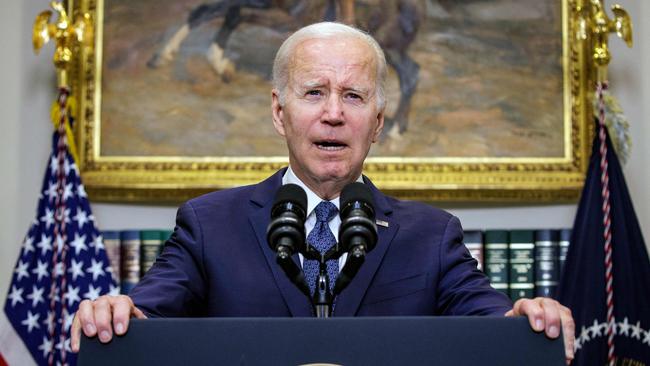What’s in the debt-ceiling deal
The long-awaited agreement between Joe Biden and Kevin McCarthy includes spending caps, work requirements and permitting.

President Biden and House Speaker Kevin McCarthy reached an agreement to raise the debt ceiling, with the text of the legislation being released late Sunday. The deal, which comes after several long days of talks, raised the debt ceiling until January 2025, past the next presidential election.
Here are some major components of the deal.
Spending
The deal holds non-military spending roughly flat for the 2024 fiscal year from this year, after factoring in some appropriations adjustments. The deal sets a 1 per cent cap on spending increases for the 2025 fiscal year. House Republicans portrayed the 2023 spending level as a rollback to fiscal 2022 levels.
The deal also includes a provision that forces a 1 per cent cut in government spending if all 12 appropriations bills aren’t passed by the end of this year.
Military spending in fiscal 2024 would be roughly at the level of Biden’s fiscal 2024 budget request, a 3 per cent increase to $US886bn ($A1.36 trillion), according to an outline of the deal and talking points that were disseminated by the White House to Democratic lawmakers. There will be $US121bn for veterans programs. The deal calls for $US637bn for other nondefense programs, which the White House described as about flat with current 2023 levels, once appropriations adjustments are made.
The White House has previously said those spending restrictions would reduce government spending by roughly $US1 trillion versus the baseline forecast over a decade.
Some Republican lawmakers had insisted on deep cuts laid out in a bill passed by the House in April, which would have rolled back spending levels to fiscal 2022 and then capped growth at 1 per cent for a decade. Democrats had called those cuts a nonstarter.
IRS Funding
The deal would cut $US10bn that the Internal Revenue Service funding had planned to use for a decadelong effort to boost tax enforcement and modernise its technology. Congress had provided $US80bn to those plans last year.
Covid-19 Aid
A person familiar with the negotiations said the deal would claw back some unspent money that Congress passed to battle the pandemic. One GOP lawmaker said the amount was estimated to be about $US29bn.
Work Requirements
The White House agreed to a key GOP demand: tightening work requirements for federal aid, primarily by temporarily raising the age of people who must work in order to receive food aid through the Supplemental Nutrition Assistance Program, or SNAP.
The tentative deal would largely require able-bodied, low-income adults without dependents between the ages of 18 and 54 to work to receive food aid, up from the current top age of 49. Currently, under rules resuming in all states by July, these adults can receive benefits for no more than three months within a three-year period, unless they are working or enrolled in a work program.
In an effort to make the change more palatable to Democrats, the deal is also expected to eliminate the work requirements for veterans, homeless people and young people leaving foster care, according to people familiar with the negotiations. Both these new exceptions and the higher age limit would end by October 2030.
The deal also makes some under-the-hood adjustments to how states can decide to grant exemptions for individuals to the existing work requirements for food aid. Currently, states can opt to drop the work requirements for up to 12 per cent of recipients, which would be lowered to 8 per cent under the agreement.
The Agriculture Department, which operates the food-aid program, will also be required to publish states’ applications for waivers, which are used to waive the work requirements for an area, such as a county or state.
The deal is also expected to modify the formula used by states to calculate cash assistance for low-income households under the Temporary Assistance for Needy Families program. Negotiators opted not to impose work requirements on Medicaid recipients.
Permitting of Energy Projects, Including Mountain Valley Pipeline
The bill imposes a two-year timeline for the most complicated environmental reviews required for large-scale energy and infrastructure projects and gives project developers the right to sue to meet the deadline. Speeding up reviews, which currently take an average 4.5 years, has been a top priority for Republicans.
The agreement also requires that a single federal agency take charge of a project’s environmental review, assuming responsibility for the review’s timeline. Right now, multiple agencies often perform their own, individual environmental assessments, which extends the review process.
That change is one that both parties have expressed support for in the past. It resembles a provision of the 2021 infrastructure spending law that gave one federal agency the task of completing environmental reviews for transportation projects.
The bill also specifically expedites the remaining permits for the Mountain Valley Pipeline, a 303-mile natural-gas pipeline in West Virginia and Virginia. West Virginia Sens. Joe Manchin, a Democrat, and Shelley Moore Capito, a Republican, have pushed to speed up completion of the pipeline.
-Siobhan Hughes contributed to this article.
The Wall Street Journal


